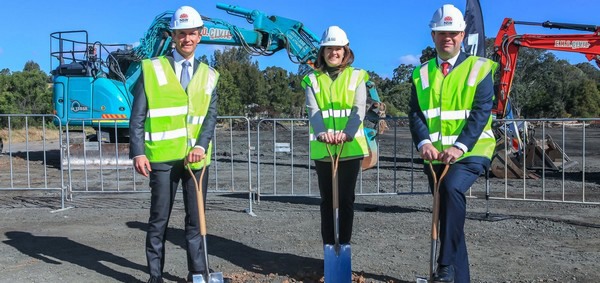Construction of a new state-of-the-art National Herbarium of NSW has officially commenced with NSW Ministers turning the sod at the Australian Botanic Garden Mount Annan during National Science Week.
A ground-breaking day
As Australia’s oldest scientific institution, the Royal Botanic Gardens & Domain Trust has spent over 200 years discovering, researching and protecting plants. In this challenging era of climate change, it is imperative now more than ever, that we understand the impacts to our natural environment and drive effective conservation solutions.
As part of the Western Sydney City Deal, the NSW Government announced a $60 million package to fund the construction of brand new National Herbarium of NSW at the Australian Botanic Garden Mount Annan to safeguard the growing collection of over 1.4 million botanical specimens. 
On Thursday 20 August, 2020 NSW Minister for Planning and Public Spaces the Hon. Rob Stokes, NSW Minister for Jobs, Investment, Tourism and Western Sydney the Hon. Stuart Ayres, the local member for Camden Mr Peter Sidgreaves MP and Botanic Gardens Greater Sydney Chief Executive Denise Ora officially announced the construction with a sod turning for the new Herbarium.
A new Herbarium, Nursery and digitising the collection
The National Herbarium of NSW collection is currently located at the Royal Botanic Garden Sydney and over 8000 new plant specimens are added to it every year, exhausting the storage capacity by 2022.
The new state-of-the-art Herbarium facility will join the award-winning Australian PlantBank at Mount Annan, to ensure the survival of plants and build more resilient ecosystems for future generations.
The Herbarium collection has recently been valued at $299.2 million and houses some of the most significant and important botanical collections in Australia. These include over 800 specimens collected by botanists Joseph Banks and Daniel Solander on Captain Cook’s first voyage to the Pacific in 1770.
Six protective vaults made of thermal mass materials will shield the growing collection of over 1.4 million plant specimens from bushfires and other extreme temperature events. The seed pod of NSW’s floral emblem, the waratah, is the main inspiration for the design of the new Herbarium, which also includes ecologically sensitive and energy saving features.
The largest herbarium imaging project in the southern hemisphere is also currently underway at the Royal Botanic Garden Sydney with over 1.4 million Herbarium specimens becoming high-resolution digital images that everyone around the world will be able to access.
Picturae is one of the world’s most renowned digitisation companies and is undertaking the project in partnership with International Conservation Services and Alembo. It will help researchers make new discoveries to advance science and conservation and it assists in protecting our valuable collection.
The construction of a new Nursery at the Australian Botanic Garden Mount Annan was also recently completed - the first upgrade for the important facility in 30 years. The new 6,400m2 production space has new structures that can meet the future needs of our Garden’s horticulture, research and conservation initiatives.
The new Herbarium design was created by leading Australian architectural firm Architectus with Richard Leplastrier and Craig Burton in conjunction with FDC Construction & Fitout and is due to be completed in 2021.
New Australian Institute of Botanical Science
The new Herbarium and Nursery along with all of the Gardens' scientific facilities, programs and living collections at the Royal Botanic Garden Sydney, Australian Botanic Garden Mount Annan and Blue Mountains Botanic Garden Tomah are being united under the new Australian Institute of Botanical Science.
The Institute will be one of the nation’s premier botanical research organisations, advancing fundamental knowledge of flora and driving effective conservation solutions to ensure the survival of plants, and all life that depends on them.
They’re now actively seeking to partner with philanthropists, industry and governments to invest in our science programs, including delivering the largest science education program to school-aged children in the country that will inspire future generations of scientists to tackle some of our biggest environmental challenges.
Source: The Royal Botanic Garden Sydney
